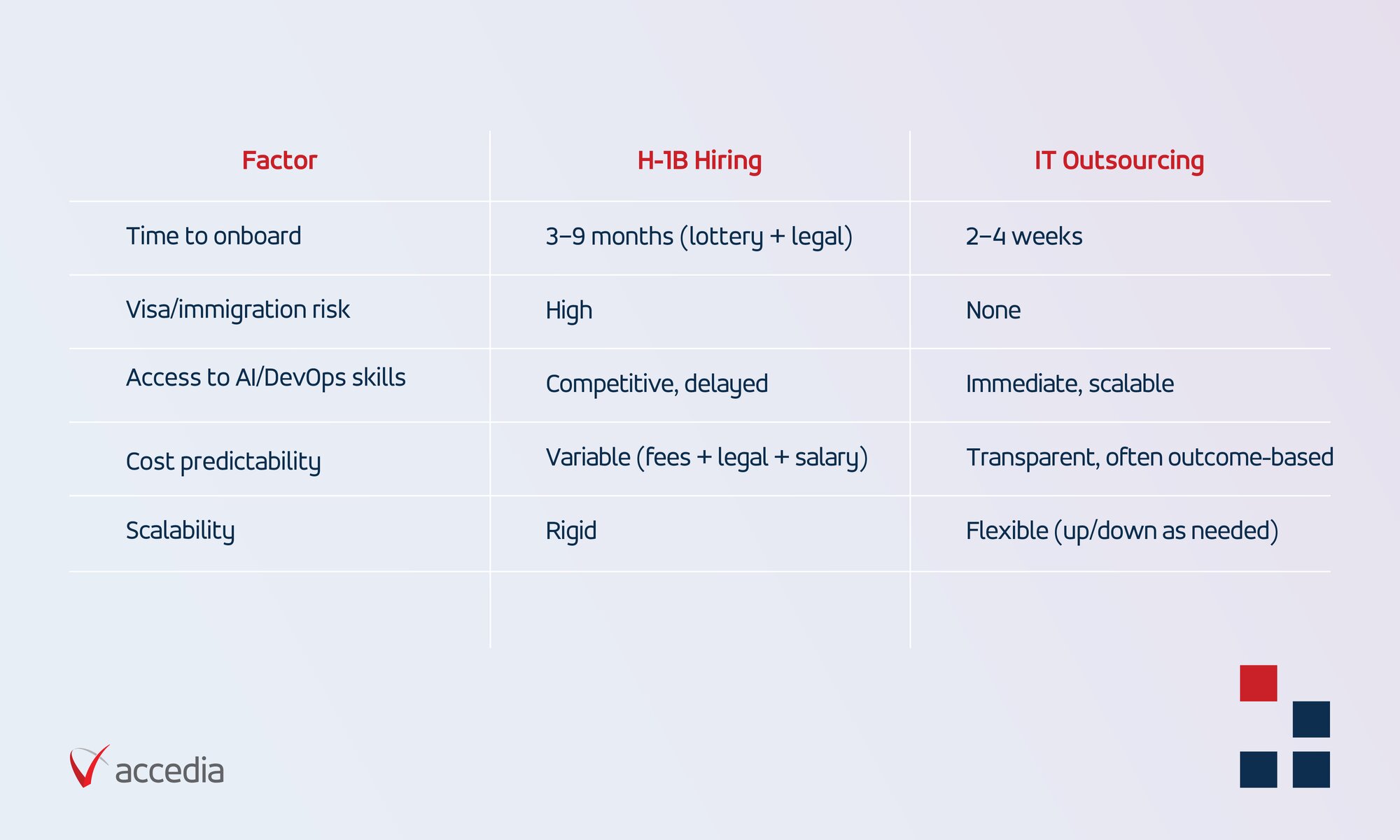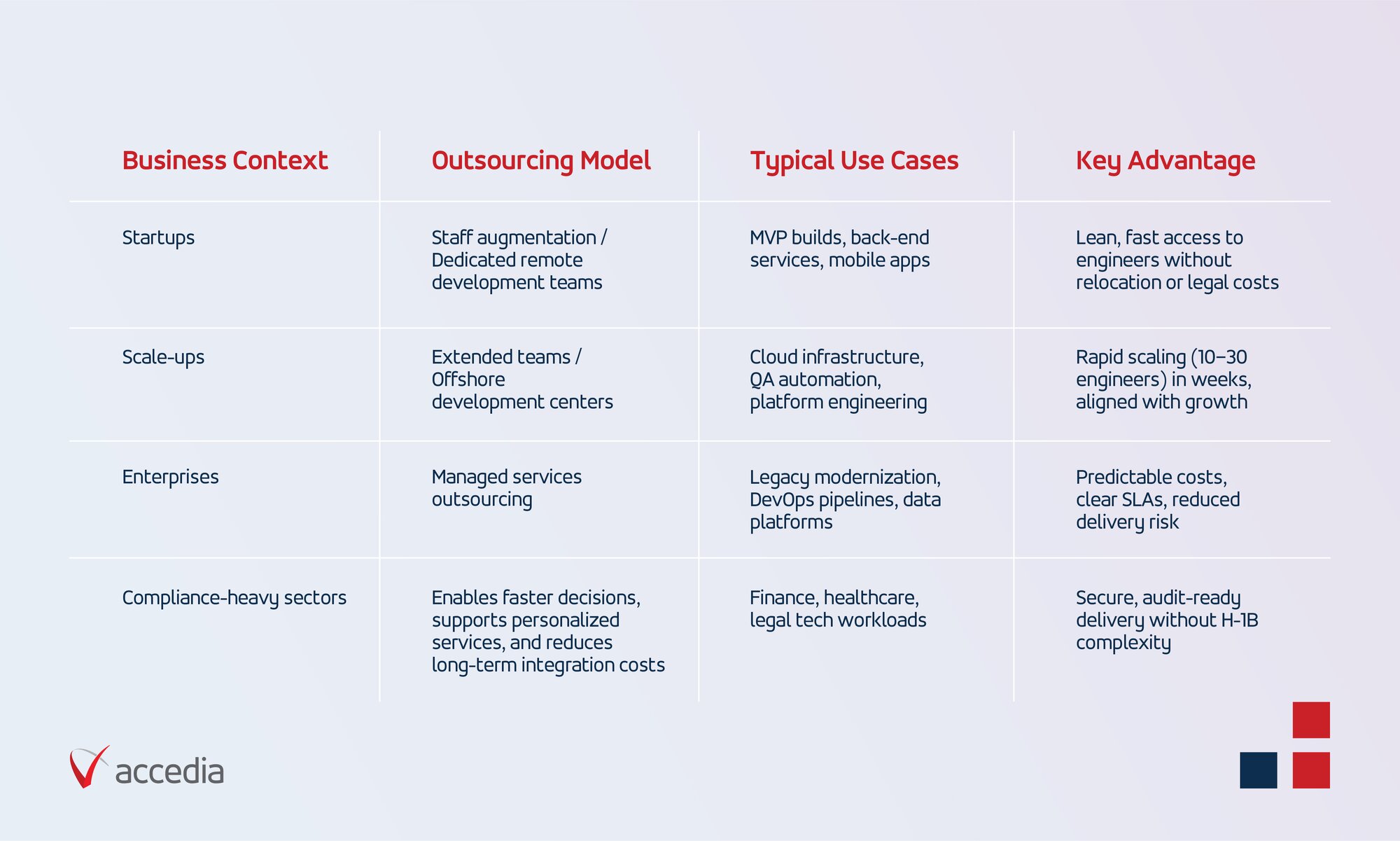The #1 Alternative to H-1B Hiring: Build Your Tech Team Without Visa Delays
25.09.2025
This September 2025, sweeping changes to the H-1B visa program have introduced new hurdles for U.S. businesses — especially those in tech. Among the most disruptive updates? A $100,000 application fee for certain employers and a lottery system now weighed toward higher-paid applicants — putting early-career and mid-level roles at a disadvantage.
While these changes apply across sectors, their impact is particularly acute for CTOs, Heads of Engineering, and IT Sourcing leaders. Why? Because over 60% of all H-1B visa holders work in computer-related occupations — roles that directly fuel software delivery, product development, and digital transformation efforts.
For fast-scaling startups and mid-sized enterprises competing for top-tier developers, this isn’t just an HR issue — it’s a delivery risk. Visa sponsorship now comes with higher costs, longer timelines, and far less predictability.
So, how can you build and scale high-performing tech teams without being dependent on the H-1B pipeline?
In this article, we’ll explore the most strategic H-1B hiring alternative to help you stay competitive, compliant, and cost-efficient.
The New H-1B Reality: Costs Up, Certainty Down
In 2025, what was once a (somewhat) predictable path to hiring international tech talent is now fraught with both financial and strategic risk. he 2025 H-1B changes have raised the pressure — though not all provisions are finalized.
What’s Already Signed & What’s Still in Proposal
On September 19, 2025, President Trump signed a presidential proclamation imposing a onetime $100,000 application fee on new H1B visa petitions between September 21, 2025, and September 21, 2026. Existing H1B holders and renewals are exempt under this proclamation.
The rule is intended to apply to new applicants only, not to renewals or those whose H1B visas were issued prior to September 21, 2025. Clarified in USCIS FAQs and official proclamations Employment Law Worldview, Sept 22, 2025.
Some broader changes — like the lottery reweighting, prioritizing higher wage roles, and shifting away from a pure random lottery model — remain in the proposal or rulemaking stage. The administration has submitted proposed regulations and opened them for public comment, detailed in recent news reports Reuters, Sept 23, 2025.
As of now, the weighted lottery rule is not confirmed in final regulation, so it still carries uncertainty around implementation timing and scope.
In short, the $100K fee is now official (for specified new filings), while the more structural shifts to how visas are allocated remain under legislative, regulatory, or administrative debate.
How the New Rules Amplify Cost & Strategic Risk
Even with only some elements in force, the practical impact on tech hiring is already being felt. Here’s how:
Cost Burden Jumps Disproportionately
The $100,000 fee dramatically increases the fixed cost of each visa petition for employers, which is particularly painful for firms that previously budgeted only for standard USCIS and DOL fees.
Because the fee applies only to new filings, it raises the relative cost of scaling headcount via H1B hires — dissuading “just-in-time” additions of talent.
Midlevel & Early-Career Roles Become Unviable
In the proposed changes, selection preference shifts to roles that command higher salaries. This structurally disadvantages mid-range roles in the middle of the pay spectrum (software engineers, data engineers, DevOps) that are essential but not ultra-premium.
As a result, many organizations may be forced to raise baseline pay for these roles just to compete in the lottery — upsetting internal budgets and compensation structures.
Regulatory & Audit Exposure Increases
With a higherstakes system, employer scrutiny, compliance enforcement, and audits are expected to rise. The administrative burden of ensuring precise documentation, wage compliance, and site matching becomes more critical.
Any misstep can lead to delayed petitions, rejections, or penalties — making the H1B route riskier from a project timeline perspective.
Uncertainty in Timing & Outcomes
Because some changes are still proposed, there's ambiguity about how quickly they’ll be enforced, how the rules will be interpreted, and whether legal challenges will block or modify parts.
This ambiguity makes long-range planning difficult — teams can’t reliably forecast how many slots they’ll secure or much they’ll pay.
Who Gets Squeezed — and Why
The impact of the new H-1B rules won’t be felt evenly across the tech landscape. Certain organizations — and the roles they rely on — will face sharper pressure than others.
Companies Under Strain
- Small and mid-sized tech firms
Without deep financial reserves or in-house immigration specialists, these firms struggle to absorb the steep $100,000 application fees and added compliance overhead.
- Cost-sensitive startups
For founders managing short runways and tight budgets, the unpredictability of H-1B hiring makes visa-based scaling unrealistic. Every dollar redirected to legal fees and applications is a dollar not spent on product or growth.
- Firms hiring at scale
Companies ramping large engineering squads will feel the compounding effect most acutely, as each new visa petition multiplies cost and regulatory risk.
Roles at Risk
- Mid-level software engineers
Essential to most product teams but rarely commanding top-10% wages, these roles become structurally disadvantaged in a reweighted lottery.
- Data engineers and DevOps specialists
Critical for modern infrastructure and delivery velocity, yet often paid below the high-salary threshold needed to compete.
- System architects and quality engineers
Key for scaling and maintaining product reliability, but less likely to justify the six-figure visa burden for employers.
Because of these pressures, leaders in software, product engineering, AI/ML, cloud development, and platform teams are now viewing the H1B route less as a reliable tool and more as a volatile bet. That’s fueling accelerated interest in H1B hiring alternatives — solutions that bypass visa unpredictability entirely.
Even industry leaders are voicing concerns. Elon Musk, a former H-1B recipient, warned:
“Immigration reforms should balance protecting jobs with attracting the brightest minds worldwide. These abrupt visa fee hikes risk harming U.S. tech leadership.” (Business Insider, Sept 22, 2025)
Smarter Move: Embrace IT Outsourcing
For engineering leaders seeking predictability, speed, and scale, the smartest path forward is no longer immigration-dependent hiring — it’s IT outsourcing.
As the H-1B hiring alternatives landscape evolves, offshore software development has emerged as one of the most effective ways to maintain delivery velocity without getting entangled in regulatory delays or six-figure visa fees.
Unlike the traditional H-1B model, IT outsourcing offers a more flexible and cost-efficient way to:
- Access top-tier engineering talent — often the very same skill profiles that dominate the H-1B applicant pool
- Bypass visa and immigration complexity, including lotteries, audits, and legal overhead
- Scale engineering teams on demand, whether you’re spinning up a prototype or staffing a full product launch
For U.S. companies under pressure to do more with less, outsourcing isn't just a contingency plan — it’s a strategic enabler of speed and innovation.

With outsourcing, you can stand up a fully operational engineering team in weeks — not quarters — and avoid the overhead that comes with immigration sponsorship.
How U.S. Tech Teams Are Replacing H-1B Hiring in Practice
Shifting away from visa-dependent hiring isn’t just theoretical — many companies are already making the move. Whether driven by budget constraints, product velocity, or compliance pressures, U.S. organizations are turning to outsourcing and offshore talent models as scalable, lower-risk alternatives.
Here’s how that pivot plays out across different stages and sectors:
Startups: Protect Budget and Extend Runway
Startups typically operate under high uncertainty and short runways. With a $100,000 visa fee now part of the equation, hiring through H-1B is no longer viable for most early-stage companies.
Instead:
Partnering with vendors to set up dedicated remote development teams — for MVP builds, back-end services, or mobile apps — allows startups to stay lean while accessing experienced talent without relocation or legal overhead.
Result: Funds that would’ve gone toward legal fees and waiting periods are redirected to product delivery, go-to-market, and revenue-generating efforts.
Scale-ups: Expand Teams Without Bottlenecks
Growth-stage companies often need to scale quickly, especially after new funding rounds or major client wins. Waiting for visa approvals can stall execution just when speed matters most.
Instead:
Leveraging outsourcing partners allows you to onboard 10–30 engineers in a matter of weeks — covering critical skills like cloud infrastructure, QA automation, and platform engineering.
Result: Teams scale to meet aggressive product roadmaps without the delays and unpredictability of H-1B sponsorship.
Enterprise IT Leaders: De-risk and Diversify
Even large enterprises are reassessing over-reliance on visa-based hiring. Delivery resilience now requires geographic and operational diversification, especially when internal teams are stretched thin or focused on strategic priorities.
Instead:
Outsourcing specific workstreams — such as legacy system modernization, DevOps pipelines, or data platform builds — reduces the pressure on internal teams while introducing cost predictability and flexibility.
Result: Delivery risk is mitigated, and enterprise teams gain more control over resource allocation across departments or programs.
Compliance-Driven Sectors: Prioritize Security and Standards
Compliance-Driven Sectors: Prioritize Security and Standards
Industries like finance, healthcare, and legal tech must meet strict regulatory requirements — from GDPR and ISO 27001 to HIPAA and PCI DSS. Hiring cross-border engineers through H-1B may introduce data sovereignty or audit challenges.
Instead:
Partnering with outsourcing firms that are certified in relevant standards ensures sensitive workloads are handled in secure, compliant environments — often with documented controls and audit trails built in.
Result: Teams scale without sacrificing governance, and vendor ecosystems align with internal risk and security frameworks.

These examples show that outsourcing isn’t a one-size-fits-all decision — the right model depends on your stage, priorities, and risk profile. Startups benefit from lean dedicated teams, scale-ups gain speed from extended offshore centers, enterprises reduce complexity through managed services, and compliance-heavy sectors ensure security by working with certified partners.
What unites them all is a shift away from visa dependency toward more predictable, scalable, and resilient ways of building tech teams.
Choosing the Right IT Outsourcing Destination
Once companies decide to shift from H-1B dependency to outsourcing, the next question is where to build those partnerships.
For U.S. tech leaders exploring outsourcing alternatives, offshore software development in regions like Asia and Eastern Europe, or nearshore development in Latin America, offers distinct advantages. Europe — particularly Central and Eastern Europe — stands out for its balance of engineering excellence, time zone compatibility, and regulatory alignment.

Latin America: Real-Time Collaboration
Countries like Mexico, Colombia, and Argentina provide strong advantages in terms of time zone overlap. Agile teams that thrive on real-time stand-ups and close collaboration often find Latin America attractive, especially when speed of communication is critical. Proximity to the U.S. also makes short business trips practical.
Potential Drawbacks: Talent pools can be smaller compared to Asia or Europe, and regulatory frameworks vary widely between countries. In major hubs, growing competition for skilled developers may also push costs upward.
Asia: Scale and Deep Talent Pools
India, the Philippines, and Vietnam remain dominant players for outsourcing at scale. Their vast developer bases and specialized expertise — from enterprise software engineering to data analytics — make them highly competitive on cost.
Potential Drawbacks: The trade-off often lies in significant time zone challenges, which can slow communication, and the need for tighter project governance to ensure quality and alignment.
Europe: Balance of Quality, Compliance, and Culture
Central and Eastern Europe, including countries like Poland, Romania, and Bulgaria, strikes a balance that resonates with U.S. tech leaders. The region offers:
- High-quality engineering talent with strong track records in AI/ML, DevOps, and enterprise product development.
- Cultural and business alignment with Western work practices, making collaboration smoother than in many other regions.
- Regulatory strength, with GDPR-driven standards and certifications like ISO 27001 ensuring data security and compliance — a key differentiator for industries like finance and healthcare.
- Time zone compatibility, allowing for partial to full overlap with U.S. teams, often more convenient than Asia while still offering scalability.
This combination of technical skills, governance, maturity, and business culture makes Europe not just an outsourcing hub, but a strategic partner region. Many U.S. companies are evolving beyond short-term contracts and forming long-term partnerships with European firms that act as genuine collaborators in innovation.
To deepen your understanding of why Bulgaria (and more broadly, Central/Eastern Europe) is a particularly strong outsourcing region, you may find this white paper useful: The Pros of Bulgarian Custom Software Development Companies.
Rethink Your Tech Hiring Strategy for a Post–H-1B World
For U.S. companies navigating the aftermath of the H-1B visa changes in 2025, one thing is clear: relying solely on immigration-based hiring is no longer sustainable — or strategic. Costs are higher, timelines are longer, and outcomes are more uncertain than ever.
But this shift creates an opportunity to build smarter and more resilient teams. Here are five takeaways to guide your next move:
- Diversify Talent Strategies. Don’t tie growth to a single pipeline like H-1B. Blend in global outsourcing, nearshore partnerships, and remote-first hiring.
- Start with a Pilot Project. Test outsourcing partners on a defined project — such as QA, cloud migration, or MVP development — before scaling.
- Prioritize Compliance & Security. Ensure vendors meet industry standards (ISO 27001, SOC 2, HIPAA, GDPR) to safeguard data and reduce regulatory risks.
- Integrate, Don’t Isolate. Treat outsourced engineers as part of your core team. Shared tools, daily stand-ups, and transparent reporting foster alignment and accountability.
- Measure Outcomes, Not Hours. Define KPIs like sprint velocity, defect reduction, or time-to-market improvements to ensure outsourcing delivers business impact, not just lower costs.
The future of tech hiring isn’t about borders or visas — it’s about building teams that can scale quickly, deliver reliably, and adapt to uncertainty. By rethinking your approach now, you position your organization to innovate faster, smarter, and without bottlenecks.
For a deeper look at how U.S. companies are forming successful cross-Atlantic partnerships, read: Strategic Tech Partnerships: How U.S. Companies Find the Right Fit